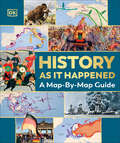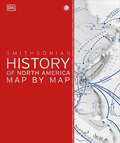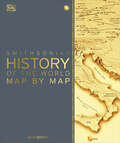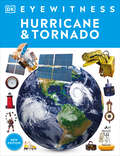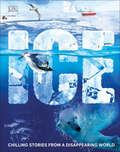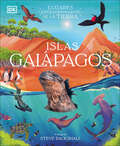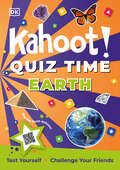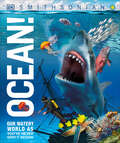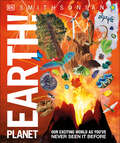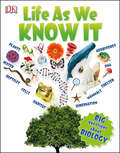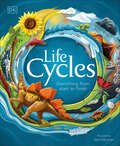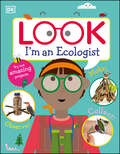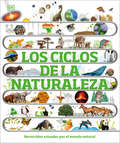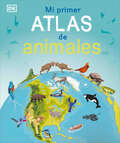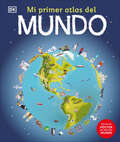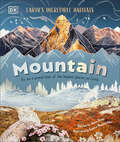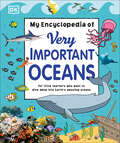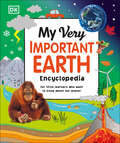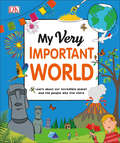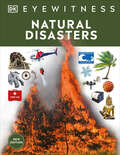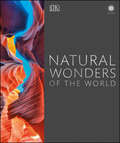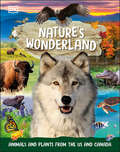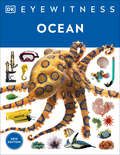- Table View
- List View
History as it Happened
by DKPore over more than 200 maps of the past to understand the world of the present in this children's history book with a difference.Watch the rise and fall of great empires and kingdoms, follow explorers of land and sea on their journeys of discovery, and learn how lucrative trade routes of spices and silk have all changed the way our world looks today.Hundreds of specially commissioned maps guide you through key moments in history, or show how things changed over time. Historical photographs help bring this history to life, while clear, bite-size text allows you to easily follow the story of humankind.History As It Happened breaks down history into simple, manageable chunks. Explore ancient Rome from its beginnings as a small kingdom, through the growth of its power as a republic, to its greatest glory as a continent-spanning empire. With this piece-by-piece approach to investigating history, and with its truly global and inclusive content, this is a children's history atlas like no other!
History of North America Map by Map (DK History Map by Map)
by DKA visual journey through the history of North America via a series of engaging, detailed maps, explaining key events and eras from prehistory to the 21st century.Specially created maps tell the story of this vast region: the first human populations and the lands of indigenous peoples; the complex ancient civilizations that arose in Mexico; the first Westerners to arrive on the shores, from the Vikings to the Mayflower; early settlements and the devastating consequences for the indigenous population; the stories of enslaved people and the abolition of slavery; the American Revolution and Civil War that shaped the modern United States; the Mexican-American War; the founding of Canada; and the industrial era and the growth of a global superpower. Brand new maps are accompanied by historic maps, documents, and artefacts, while timelines clearly lay out the chronology of events. Each era is introduced and explained, while features offer a closer look at selected moments. Whether for casual browsing or a deep dive into the past, History of North America Map by Map is essential reading for anyone who wants to know more about this fascinating land.
History of the World Map by Map (DK History Map by Map)
by DKExplore the history of the world in unprecedented detail with this ultimate guide to history throughout the ages. Maps don't just show us where to go, but also where we've been. If you're interested in finding out more about the biggest events in world history, then this book all about history of the world is perfect for you!This stunning history book for adults starts with the evolution and migration of our oldest ancestors out of Africa. You can then look up maps about the Greece and Persian War, the Mongol Conquests, Medieval Europe's trade routes, and the rise of the Ottomans. Explore maps about the colonisation of North America, the scientific revolution, Napoleon's advances, and Britain's control of India. Then uncover the history of later centuries, such as the Age of Imperialism, the American Civil War, industrialised Europe and the transformation of Japan.Journey into past like never before as you uncover:- Easy-to-read text panels for a deeper understanding of history- A total of 140 maps alongside stunning pictures and informative timelines- Storytelling maps to bring history to life- Published in association with the Smithsonian Institution in the USA.Bursting with striking illustrations and full of fascinating detail, this history book is the ultimate gift for map lovers, history enthusiasts of all ages and those who enjoy visiting museums and other historical sites, whether as a present for dad, or handy reference guide for any other history lover in your life! History of the World Map by Map aims to help you gain a strong understanding of some of the forces and movements across continents that have shaped our world!Go on guided tour through time and explore:- Prehistory 7 MYA-3000 BCE- The Ancient World 3000 BCE - 500 CE- Middle Ages 500-1450 CE- The Early Modern World 1450-1700- Revolution and Industry 1700-1850- Progress and Empire 1850-1914- The Modern World 1914-PresentAt DK, we believe in the power of discovery.So why stop there? The Map by Map series includes other titles such as History of the World Map by Map and World War II Map by Map, each detailing historical events and placing them in the context of geography. DK's luxurious Map by Map books are fantastic history gifts, packed with fascinating facts, high-quality photography, and detailed profiles and descriptions of people and events.
Hurricane and Tornado (DK Eyewitness)
by DKBecome an eyewitness to nature&’s most extreme weather phenomena. See inside the eye of a cyclone, witness hailstones the size of tennis balls, and learn how a gentle mountain stream can become a raging surge within a few minutes. Discover a bridge that collapsed due to severe gusts of wind, and learn about a tree species in southwest Africa that can survive several years of drought. Along the way, you&’ll uncover historical items that reveal how ancient civilizations predicted the weather as well as the weather-forecasting techniques that have developed over the centuries and how human activity can cause weather patterns to change.Loved and trusted for over 30 years, Eyewitness has a new look and even more content:• A bite-sized formula of text with images that kids love!• Fully revised and fact-checked by subject specialists• Packed with facts, infographics, statistics, and timelines• Updated with brand new eyewitness accounts from experts in the fieldEyewitness Hurricane & Tornado uses a groundbreaking visual layout that makes learning fun for kids aged 9-12. With striking images, models, and illustrations, this visual guide offers a unique view of catastrophic weather conditions. From polar regions to the tropics, this storm book shows the effects of nature&’s most extreme weather.Eyewitness content approved by -ologists!DK&’s Eyewitness kids books are updated and fact-checked by subject specialists, with brand new first-hand eyewitness accounts throughout from experts in the field. A best-selling series known and trusted for generations, with a fresh new look and up-to-date content. What will you Eyewitness next?Join the journey to combat climate change with Eyewitness Climate Change or leave no stone left unturned with Eyewitness Rock & Mineral. Do you think you&’ve found your topic of interest? DK has even more extreme weather books for kids and adults alike find them all by searching for &“DK weather books&”.
Hábitats del mundo (Habitats of the World): Un viaje por los ecosistemas de la Tierra
by DK- Contiene 14 impresionantes ilustraciones CGI a doble página, repletas de la vida vegetal y animal.- Este maravilloso formato ha vendido más de 770.000 ejemplares en todo el mundo.Un viaje ilustrado a través de los hábitats más sorprendentes de la Tierra, desde bosques y océanos hasta desiertos y polos helados.Ilustrado con increíble detalle, Hábitats del mundo explora los principales ecosistemas de la Tierra y las diferentes comunidades de animales y plantas que viven en cada uno. Desde una abundante selva tropical hasta las condiciones hostiles de alta montaña o los polos helados, descubre cómo los animales y las plantas se adaptan a su entorno y cómo interactúan con su entorno y entre ellos.------------------------- Shows 14 panoramic CGI artworks show each major habitat teeming with life.- In the same lavish, landscape format as the successful Through Time series, which has sold over 770,000 worldwide.Beautifully detailed panoramic artworks show each major habitat teeming with life—each scene is packed with drama and intricate details to pore over.
Ice: Chilling Stories from a Disappearing World
by DKFrom the mighty mammoths and deserts of ice to early explorers and polar survival, come face to face with one of Earth's greatest resources: ice.With captivating CGIs, illustrations, and photography, DK's Ice will take readers on an epic journey from the ice age to modern day, exploring how icy worlds are created, how creatures live in these harsh environments and the impact of climate change.Learn about early humans and how they survived in one of the most hostile environments on Earth, the tragic and treacherous journeys of early polar explorers, how icy landscapes develop and change, and meet the animals who make these frozen lands their home. Detailed annotations explore the place of ice on our planet and how we and other animals survive and interact with it. Ice is the perfect companion for any reader who wants to discover frozen worlds and the creatures that make them their home.
Islas Galápagos (Galapagos)
by DKTortugas gigantes, lobos marinos, fragatas, flores paradisíacas y arrecifes…Las Islas Galápagos no se conocen como Islas Encantadas porque sí. Se ganaron este nombre por su grandiosa biodiversidad de flora y fauna, que atrajo biólogos de todo el mundo desde hace siglos.Con un enfoque educativo y diseño atractivo, esta guía para niños es un recorrido ilustrado y fotográfico de la flora, fauna y geología de uno de los lugares más singulares y ricos en naturaleza del planeta.- Hermosas ilustraciones y fascinantes fotografías acompañadas de texto escrito por expertos.- Mapa de las islas y explicaciones sobre su formación, para que los niños las identifiquen fácilmente y aprendan su origen.- Información detallada de las especies (terrestres y marinas) que las habitan y de la geología del archipiélago.- También incluye una sección en la que se explican los esfuerzos por su conservación.-Con notas sobre cómo estas islas fueron fuente de inspiración para Darwin y su teoría de la evolución.Especies endémicas, animales increíbles, clima, evolución, migración y mucho más. Descúbrelo todo de este lugar único en nuestra planeta y de su visitante más famoso: Charles Darwin. Un libro perfecto para que los niños aprendan sobre geología y biología junto a padres y profesores.
Kahoot! Quiz Time Earth: Test Yourself Challenge Your Friends (Kahoot! Quiz Time)
by DKMore than 250 trivia questions for curious minds!What is the highest mountain in the world? What is the Earth’s core made of? Find out in this quiz book, packed with questions and facts about Planet Earth. Challenge yourself, your family, and friends with awesome questions based on the award-winning online Kahoot! games. Answer the questions, keep score, and declare the winner. Scan the QR codes throughout the book to find more cool quizzes on the same topics within Kahoot! and test your knowledge further. Go for gold and make learning awesome!Kahoot! and the K! logo are trademarks of Kahoot! AS.
Knowledge Encyclopedia Ocean! (DK Knowledge Encyclopedias)
by DKExplore the deep blue as you&’ve never known before with this children's encyclopedia perfect for a young explorer.Forming part of a fantastic series of kid's educational books, this bold and brilliant kid's encyclopedia uses ground-breaking CGI imagery to reveal the world as you've never seen it before. Informative, diverse in subject matter, easy to read and brimming with beautiful graphics, young learners can explore the incredibly detailed cross-sections and cutaways that reveal the inner workings of our incredible oceans. This charming children&’s encyclopedia opens the world in new ways, with: - Packed with facts, charts, timelines, and illustrations that cover a vast range of topics. - Encompassing a visual approach with illustrations, photographs and extremely detailed 3D CGI images.- Crystal clear text distills the key information.- DK's encyclopedias are fact-checked by subject experts to offer accuracy beyond online sources of information.This fully-updated edition of Knowledge Encyclopedia Ocean! is the perfect encyclopedia for children aged 9-12, ideal for inquisitive minds, covering the topics of ocean science, seashores, polar oceans, ocean maps and so much more! Jam-packed with fun facts about sea creatures and ocean environments, you can explore sharks, jellyfish, turtles, dolphins, octopuses, penguins, and seahorses, fish and an array of other animals that call the ocean their home. Explore, Discover And Learn!DK's Knowledge Encyclopedia Ocean! uncovers the marvels of the underwater world in unprecedented detail and with stunning realism. Encompassing engaging facts about animal behavior under the water, including a closer look at the geography, geology, and ecology that lies beneath the waves from the dramatic landscapes of the deepest trench and towering underwater chimneys, to coastal coral reefs and kelp forests teeming with life, you can spend quality time diving into the deep blue with your children, accompanied by impressive visuals to engage their senses. A must-have volume for curious kids with a thirst for knowledge, this enthralling ocean encyclopedia is structured in such a way that your child can read a bit at a time, and feel comfortable to pause and ask questions. Doubling up as the perfect gift for young readers, who are always asking questions about the underwater world. At DK, we believe in the power of discovery. This thrilling kid&’s encyclopedia is part of the Knowledge Encyclopedia educational series. Celebrate your child&’s curiosity as they complete the collection and discover diverse facts about the world around them. Explore the animal kingdom like never before with Knowledge Encyclopedia Animal! Travel back in time to when dinosaurs roamed the earth with Knowledge Encyclopedia Dinosaur! And hone your knowledge on how the human body works with Knowledge Encyclopedia Human Body! Whatever topic takes their fancy, there&’s an encyclopedia for everyone!
Knowledge Encyclopedia Planet Earth!: Our Exciting World As You've Never Seen It Before (DK Knowledge Encyclopedias)
by DKExplore planet Earth like you&’ve never known before with this perfect children's encyclopedia for a young explorer.Forming part of a fantastic series of kid's educational books, this bold and brilliant kid's encyclopedia uses ground-breaking CGI imagery to reveal the world as you've never seen it before. Informative, diverse in subject matter, easy-to-read and brimming with beautiful graphics, young learners can explore the incredibly detailed cross-sections and cutaways that reveal the inner workings of the world around them, featuring floods, hurricanes, volcanoes, deserts and more.This charming children&’s encyclopedia opens the world in new ways, with: - Packed with facts, charts, timelines, and illustrations that cover a vast range of topics. - Encompassing a visual approach with illustrations, photographs and extremely detailed 3D CGI images.- Crystal clear text distills the key information.- DK's encyclopedias are fact-checked by subject experts to offer accuracy beyond online sources of information.SI Knowledge Encyclopedia: Planet Earth! covers everything you need to know about Earth in glorious technicolor detail alongside easy explanations and fun facts to spark young minds to find out about our planet and how it works. The perfect encyclopedia for children aged 9-12, ideal for inquisitive minds, young learners can discover an array of fascinating facts, such as what&’s inside Earth, and why is it so hot under the surface? How did our planet come about, and what did it look like in the beginning? How are mountains formed and why are forests important? What happens when glaciers melt and how can we stop climate change? Encourage youngsters to explore habitats and ecosystems – inside caves, among enormous redwoods, on the savannahs, or deep down under the oceans. This extraordinary encyclopedia fuels your imagination using its jaw-dropping visual approach to explain everything from what keeps Earth in its place to the great diversity of plants, animals, and people who live on it, why it is unique and how it is changing.Explore, Discover And Learn!DK's SI Knowledge Encyclopedia: Planet Earth uncovers the marvels of our world in unprecedented detail and with stunning realism. Encompassing engaging facts about Earth, including a closer look at nature, diving into the human body, the amazing world of science and our world&’s history, you can spend quality time exploring the our universe with your children, accompanied by impressive visuals to engage their senses. A must-have volume for curious kids with a thirst for knowledge, this enthralling encyclopedia is structured in such a way that your child can read a bit at a time, and feel comfortable to pause and ask questions. Doubling up as the perfect gift for young readers, who are always asking questions about our planet! At DK, we believe in the power of discovery. This thrilling kid&’s encyclopedia is part of the SI Knowledge Encyclopedia educational series. Celebrate your child&’s curiosity as they complete the collection and discover diverse facts about the world around them. Dive into the deep blue with SI Knowledge Encyclopedia Ocean! Travel back in time to when dinosaurs roamed the earth with Knowledge Encyclopedia Dinosaur! And hone your knowledge on how the human body works with SI Knowledge Encyclopedia Human Body! Whatever topic takes their fancy, there&’s an encyclopaedia for everyone!
Life As We Know It (Big Questions)
by DKAs far as we know, Earth is the only inhabited planet in the Universe. So what makes Earth such an ideal place for life to survive? And how did it all get started? Life as We Know It goes back to the beginnings of life on our planet, explaining to middle grade readers how it emerged under hostile conditions from a chemical soup as a simple self-contained unit: the cell. Key biological themes, such as how cells work, produce energy, and reproduce are explained in simple terms. This knowledge is then used to explain how more complex organisms live. The book also looks at the wide variety of plant and animal life on Earth and how it evolved, and introduces the features and characteristics of members of the six kingdoms of life. Young readers will learn how life forms have adapted to occupy particular niches and what can happen if something upsets this balance. Lavishly illustrated with images from DK's extensive natural history photo library, this encyclopedia is a visual feast as well as a thorough treatment of biology. Through DK's unique visual style, scientific ideas that might appear intimidating in a textbook are made lucid at a glance.
Life Cycles: Everything from Start to Finish (DK Life Cycles)
by DKTake a look into the circle of life through the life cycles of the planet and everything on it!Everything begins and everything ends — but what happens in between? Find out in this stunning nature book. Learn about human life and development, processes in nature, how animals change over time, how the universe was formed and so much more. This illustrated children&’s book for ages 7-11 includes: • More than 60 life cycles featured • Stunning photographs that capture key moments during a life cycle, like penguin chicks huddling together to keep warm and the beauty of an orchid in full bloom • Bite-size facts and stats about every animal, plant, planet and habitat featured • A great new angle on the world, the universe and our place in it If you&’re looking for facts about the universe then this is the book for you! Based on key concepts found in the STEM learning curriculum, Life Cycles captures life on the planet through captivating illustrations and photography, amazing facts and easy-to-read text. You&’ll take a closer look at the life cycles of environments, and extinct animals like the dinosaurs, too! The life cycles in this reference book have been carefully chosen to give you an amazing overview of the universe, and how everything is linked. Discover a new life cycle every time you turn the page: how a river forms and changes over time, how a tree grows, see how coral reefs form. Follow the life cycles of weather — from the water cycle to ice ages, to give you a better idea of the climate change we find ourselves in now.From the single-celled amoeba, mountains, and volcanoes to continents, oceans and the solar system — take a deeper look into life on earth and all its intricacies!
Life Underground: Tunnel into a World of Wildlife (DK Panorama)
by DKGo on an illustrated journey through nature&’s unseen habitats in this kids&’ book about life under the earth.Teeming with animal life, this book shows how life on Earth is interconnected and thriving in more places than you might think! Children aged 7-11 will be fascinated by what goes on under their feet, learning about the incredible diversity of life on planet Earth.Life Underground takes children on an illustrated journey into the world&’s most amazing underground habitats, from warm Arctic warrens to sandy desert dens. Explore the different communities of animals and plants that live under the Earth, from the succulent soil of an Australian forest to the hard ground at the icy north. Find out how animals and plants are adapted to their environment and how they interact with their surroundings and each other.This nature book for children offers: - Material that supports the science curriculum in schools up to Grades 3-5 – perfect for nature-loving children aged 7–11, and reluctant readers.- A look at Earth&’s major underground habitats and shows the animals that live there. - Beautifully detailed panoramic artworks show each underground scene teeming with life, with burrowing animals placed around the edge of the page for readers to find in the illustration.This illustrated guide lets children tunnel into a world of wildlife and explore different habitats, whilst teaching about different animal species and where they live. Details are drawn out from the artwork so that each habitat is easy to follow, making this the ideal nature book to have on your shelf.
Look I'm an Ecologist (Look! I'm Learning)
by DKTwenty step-by-step eco-projects for budding preschool ecologists!Calling all mini eco-warriors and their parents! This fun and exciting book is filled with nature-themed eco-projects for kids. It's a gentle introduction to topical issues in the world today, like climate change, conservation and recycling - ideal for curious kids who want to make a difference.Look, I'm an Ecologist allows young readers to do what they do best: imagine, create, learn, problem-solve, and play their way to a greener planet. Inside you'll find:- A wide range of activities with an environmental focus is supported by simple information, so young readers understand the issues faced by our planet in a play-based, hands-on and child-friendly context.- Easy-to-find and internationally available materials and resources.- Projects designed to be shared and enjoyed by children and parents or carers.- Visual step-by-step instructions allow young children to access every part of the activity - from set-up to sensory exploration and conclusion, making them actively responsible for their learning. - An expertly written book by environmentalist and zoo learning manager Cathriona Hickey, who has vast experience in communicating science and ecology topics to young children.This charming arts and crafts book for kids will help them discover that they already have what they need to become an ecologist: a curious mind, unlimited imagination and super senses! Little ones can explore a wide range of projects, including building a bird feeder, making compost, painting pebbles, weaving a spider's web, growing plants and even building a model of a rockpool!The practical activities support preschool and kindergarten curriculums with clear pictures and easy-to-follow instructions. This nature book for kids will show them how fun it is to be green and use their senses to explore the natural world!DK's Look! I'm Learning series of exciting and educational STEM books, focusing on the sensory experience of practical learning and play and finding science in everyday activities. Hands-on learning experiences tap straight into kids' insatiable curiosity and sense of wonder. Try the other titles in the series next, including Look I'm A Cook, Look I'm A Maths Wizard, and Look I'm An Engineer.
Los ciclos de la naturaleza (DK Children's Timelines)
by DKDescubre la increíble naturaleza de nuestro planeta a través de cronologías, imágenes y fotografías.Si alguna vez te preguntaste cómo será la rutina de un chimpancé, qué sucede durante las 24 horas del día en un desierto, o cuánto dura el embarazo de un canguro, este libro es para ti. Timelines of Nature te muestra la historia natural de nuestro planeta y los ciclos vitales de los seres vivos que lo habitan a través de detalladas líneas temporales y divertidos elementos visuales.En su interior, encontrarás:-Líneas de tiempo que ayudan a visualizar de forma fácil en el tiempo el desarrollo de la historia del mundo natural, desde el Big Bang y el origen de las plantas hasta la extinción de los dinosaurios.-Contenido dividido en cuatro temas principales: la Tierra, las plantas, los hongos y los animales-Esquemas y explicaciones sobre lo que sucede es el transcurso de un año en diferentes hábitats, en el ciclo vital de una planta o en el día a día de un animal.-Información y datos curiosos de los momentos y sucesos más extraordinarios de la geología, la fauna y la flora, como una mariposa saliendo de su crisálida.-Fascinantes fotografías e ilustraciones realistas de la naturaleza.¡Observa qué pasa en el planeta minuto a minuto, hora a hora y día a día en cada mes del año! Descubre cuántos años tardó la Luna en formarse, las etapas de crecimiento de diferentes animales y cómo ha evolucionado la vida desde los primeros organismos unicelulares. El recurso perfecto para estudiar biología.Discover the fascinating history of our planet with this unique collection of visual timelines.Full of exciting visual timelines covering minutes, hours, days, weeks, months, and years, Timelines of Nature reveals our planet’s natural history and its life cycles in an entirely new way. Beginning at our world’s existence; children aged 9+ will learn how many years it took the Moon to form and witness Earth’s continents collide. Discover the history of Earth’s most spectacular features – from the Grand Canyon to the Sahara desert. See how life evolved, from the first single-celled organisms to the extraordinary variety of creatures living today. Then we look at life on Earth today. Every species on Earth has its own unique story – Timelines of Nature reveals these weird and wonderful life cycles through fascinating visual timelines. It tells you what’s really happening on Earth each minute of every day. This beautiful nature book for children features:- Beautiful timelines teach young readers all about geology, plants, and animals.- Each timeline is unique and depicts a different topic, such as the story of how whales evolved, how the Moon was formed, or how a tiger spends its day.- Feature pages highlight climactic moments in nature, for example, the butterfly finally emerging from its chrysalis.- Supporting educational boxes on each page explain key points about nature, helping kids to discover more about the world around them.Children can marvel at a variety of different timeframes in nature, like geological timelines spanning thousands of years; a year in the life of a habitat, a day in the life of an animal, and complete plant life cycles.
Mi primer atlas de animales (Children's Illustrated Atlas)
by DK¿Dónde viven las jirafas? ¿En qué países hay tigres? ¿Los osos son de clima cálido o frío?Este libro para niños de 6 a 8 años reúne información sobre las características y los lugares que habitan los animales de todo el mundo, desde los osos polares del helado Ártico o los emúes de Australia hasta los tucanes de la selva amazónica y los guepardos de los desiertos africanos. A través de datos divertidos y cifras sorprendentes, los pequeños podrán aprender de manera fácil y amena dónde viven los animales, en qué hábitats se desarrollan y cuál es el clima en cada uno de ellos.En su interior, encontrarás: Un montón de datos divertidos sobre más de 600 animales de todo el mundo y más de 40 mapas a todo color que te indican en qué países se encuentran.Fotografías de calidad de las plantas y los animales más representativos de cada continente.Un manual de los contenidos del libro que explica cómo abordarlos.Juegos que pondrán a prueba lo que aprendieron y un glosario de términos.Cada página está repleta de información de un gran variedad de hábitats, desde altas montañas y áridos desiertos hasta praderas salvajes y selvas tropicales. Además, este libro educativo incluye un mapa desplegable a todo color que muestra cada rincón del mundo. ¡Lleva el reino animal a la pared de tu cuarto y vive una emocionante aventura con los animales del planeta!Bring the amazing animal kingdom right into your home! Packed with fun facts about animals and more than 40 full-color maps that detail the countries where they live.This fabulous educational book for kids zooms-in on countries and continents to show key animal habitats and locations around the world. A thrilling animal adventure around the globe, perfect for kids ages 6–8.Each colorful map in this children's book is bursting with animal facts, combining illustrations with gorgeous photographs that highlight each continent's most iconic animals. From the tallest mountains and desolate deserts to wild grasslands and tropical rain forests; it covers key habitats and locations for each country.Packed with tons of fun facts and figures, the Children's Illustrated Animal Atlas explains where these hidden habitats are found and what the local climate is like. Find descriptions and illustrations of the plants and animals that live in them, making the information easy for kids to comprehend.
Mi primer atlas del mundo (Children's Illustrated Atlas)
by DKMi primer atlas del mundo' da vida al planeta con coloridos mapas y datos fascinantes sobre los países del mundo.Cada mapa está rebosante de información, combinando ilustraciones con fotografías que representan puntos clave sobre cada país. El atlas incluye un mapa mundial, con un mapa político para cada continente. Los niños aprenderán a leer mapas con leyenda, brújula y escala. Este libro encantador e informativo será una adición imprescindible para la biblioteca de cualquier niño.DK&’s 'Mi primer atlas del mundo' brings the world to life with colorful maps and fascinating facts about the countries of the world.Each map is bursting with information, combining colorful icons with photographs representing key points about each country. The atlas includes a world map, with a political map for each continent. Children are shown how to read a map and use a key, compass, and scale. This charming and informative book is a key addition to every child&’s library.
Mountain: Go On a Grand Tour of the Highest Places on Earth (Earth's Incredible Habitats)
by DKThis stunning book all about mountains takes children on a grand tour of the highest places on Earth.From the salt flats of the Andes to the snow-capped peak of Mount Fuji, discover 14 of the world’s most spectacular mountains and mountain ranges, and the animals and plants that live in them. The chapters cover four different types of mountains: plateaus, volcanoes, mountain ranges, and tepuis, with a selection of both famous and less-well known places within each. Every mountain or range is explored in detail, with intriguing information about its geography and flora and fauna, alongside detailed photography and beautiful illustrations. Marvel at the Great Aletsch Glacier flowing down the Alps, mountain goats scrambling across cliff faces in the Rockies, and the tiny saltwort flowers that bloom 20,000 feet up in the Himalayas. As well as the wonders of these remote areas, the threats facing mountains and their species are also investigated.Habitat: Mountains will be treasured for years to come. With foil on the cover and colorful sprayed edges, this book makes the perfect gift for any child with a passion for the natural world.
My Encyclopedia of Very Important Oceans (My Very Important Encyclopedias)
by DKA charming children's encyclopedia that takes you on a journey into the deep blue to discover the wonders of the world&’s oceans!The world is so much bigger than young minds can fathom and there is always more to learn. My Encyclopedia of Very Important Oceans is a vibrant encyclopedia for curious 5-7 year olds, who want to know everything there is to know about life on and under the waves. Easily accessible to young readers through a balance of striking images and conversational, age-appropriate text, this ocean encyclopedia will tap into every child&’s natural curiosity and answer all their biggest questions about this amazing world under the water. Bursting with up-to-date facts and discoveries, this exciting kid&’s encyclopedia includes everything from the spectacular seabirds soaring over Earth&’s vast oceans, to the tiny creatures lurking on the ocean floor. Dive in and explore forgotten shipwrecks, swim with fabulous fish and other awesome underwater animals, and weave your way through secret deepsea homes. You&’ll travel back in time to meet plundering pirates, scientists, and explorers who changed the course of history, then it&’s time to learn about lots of very important underwater jobs and how you can help to protect Earth&’s precious oceans.Celebrate your child&’s curiosity as they:- Read fun facts about weird and wonderful ocean creatures- Learn important ocean conservation efforts for awareness around the climate crisis - Discover curious creatures and incredible under-the-sea adventures Our ocean encyclopedia for children is the perfect blend of striking illustrations, fun fact files and educational stats about oceanographic life. In fact, &‘oceans&’ is an on-trend topic, with more and more wildlife books with an environmental focus seeing an increase in sales. Encourage early learners to go on a journey into under the water to explore a world of information, making this the ideal first reference book for kids aged 5-7 to enjoy for hours on end, whether shared reading with the family, or reading alone, this fun fact book for children also doubles up as the perfect gift for all young ocean lovers. Tell the story of underwater world one page at a time, by uncovering: - Educational content written in a friendly and fun manner - Beautifully padded cover with several high-quality finishes, including padding and foil- Features a built-in ribbon bookmark so you never lose your place whilst reading More in the SeriesMy Encyclopedia of Very Important Oceans is part of the educational kid&’s book series My Very Encyclopedia series. Complete the series and nurture your child's curiosity with My Encyclopedia of Very Important Adventures, teach them about different species with My Encyclopedia of Very Important Animals, or let them go back in time to when dinosaurs roamed the earth with My Encyclopedia of Very Important Dinosaurs.
My Very Important Earth Encyclopedia: For Little Learners Who Want to Know Our Planet (My Very Important Encyclopedias)
by DKA charming children's encyclopedia bursting with facts about explosive volcanoes, incredible habitats, and world-saving ideas.The world is so much bigger than young minds can fathom and there is always more to learn. My Very Important Earth is a vibrant encyclopedia for curious 5-9 year olds, with a unique approach to the subject that features both places from around the globe as well as focusing on what the world is like from a child&’s perspective, covering everyday subjects about their own experiences. Full of fun facts, colourful illustrations, and games that will keep the kids entertained time again, this children&’s encyclopedia is filled with age-appropriate knowledge on a range of topics from Earth&’s inner core to the thinnest air at the edge of the atmosphere, get ready for a round-the-world adventure! Dig down and learn exactly what is under our feet. Investigate the workings of earthquakes and volcanoes. Learn howmountains are made and how rivers form. Find out about wind, rain, and extreme weather on Earth&’s surface. Explore Earth&’s habitats, and meet the plants and animals that call them home. Finally, find out about how our planet is under threat, and what you can do to protect it.Celebrate your child&’s curiosity as they:- Read hundreds of exciting facts- Learn all about geology, habitats, conservaton- Discover the wonders of our incredible planet, and moreOur encyclopedia for children is the perfect blend of adorable, simple illustrations with stunning photography and lively text. Encourage early learners to go on a journey to explore a world of information, making this the ideal first reference book for kids aged 5-9 to enjoy for hours on end, whether for homeschooling, a bedtime story, shared reading or reading alone, this fun fact book for children also doubles up as the perfect gift for curious kids who love to learn. Tell the story of the world one page at a time, by uncovering: - Educational content written in a friendly and fun manner - Beautifully padded cover with several high-quality finishes, including padding and foil- Features a built-in ribbon bookmark so you never lose your place whilst reading More in the SeriesMy Very Important Earth is part of the educational kid&’s book series My Very Encyclopedia series. Complete the series and nurture your child's curiosity with My Encyclopedia of Very Important Adventures, teach them about different species with My Encyclopedia of Very Important Animals, or let them walk with the dinosaurs who ruled the earth before them in My Encyclopedia of Very Important Dinosaurs.
My Very Important World: For Little Learners who want to Know about the World (My Very Important Encyclopedias)
by DKA charming children's encyclopedia bursting with fun facts for little learners who want to know about the world!Our world is an amazing place. It&’s full of rivers, mountains, animals, and too many other amazing places to count. But that&’s not all. There&’s also families, friends, music, technology, language, games, and all other things that make lifewonderful. This exciting children&’s book is a celebration of our world and what it&’s like to live in it. My Very Important World is a vibrant encyclopedia for curious 5-9 year olds, with a unique approach to the subject that features both places from around the globe as well as focusing on what the world is like from a child&’s perspective, covering everyday subjects about their own experiences. Unlike an atlas, this encyclopedia of discovery will entertain, educate, and inspire readers to wonder about the world around them. On one page they&’ll read about their body and brain, on another they&’ll learn about languages, food, culture, the environment, and on others, they can marvel at wonders of the Earth such as fiery volcanoes, sprawling cities, or a place called &“The Rainbow Mountains&”. My Very Important World allows readers to delight in discovering where the coldest place on Earth is, how many languages there are, why they sometimes feel scared, and much more. Full of fun facts, colorful illustrations, and games that will keep the kids entertained time again, this children&’s encyclopedia is filled with age-appropriate knowledge on a range of terrific topics, with contents divided into six sections, covering: My World, The World Around Me, People and Culture, The Big Wide World, The Natural World, and Exploring The World.Celebrate your child&’s curiosity as they:- Read hundreds of exciting facts- Learn all about amazing animals, people, and places- Discover the wonders of our incredible planet, and moreOur encyclopedia for children is the perfect blend of adorable, simple illustrations with stunning photography and lively text. Encourage early learners to go on a journey to explore a world of information, making this the ideal first reference book for kids aged 5-9 to enjoy for hours on end, whether for homeschooling, a bedtime story, shared reading or reading alone, this fun fact book for children also doubles up as the perfect gift for curious kids who love to learn. Tell the story of the world one page at a time, by uncovering: - Educational content written in a friendly and fun manner - Beautifully padded cover with several high-quality finishes, including padding and foil- Features a built-in ribbon bookmark so you never lose your place whilst reading More in the SeriesMy Very Important World is part of the educational kid&’s book series My Very Encyclopedia series. Complete the series and nurture your child's curiosity with My Encyclopedia of Very Important Adventures, teach them about different species with My Encyclopedia of Very Important Animals, or let them walk with the dinosaurs who ruled the earth before them in My Encyclopedia of Very Important Dinosaurs.
Natural Disasters (DK Eyewitness)
by DKDiscover the awesome power of nature in this visual guide to the dynamic natural phenomena across our planet.Become an eyewitness to the weird and wonderful ways of our world, from tsunamis to tornadoes, and discover nature's awesome potential with this Eyewitness guide. See how earthquakes, floods and hurricanes affect what lies in their path, and what measures we can use to protect ourselves from Mother Nature. Follow the journey of some of the most catastrophic disasters, and witness the rescue operations that followed. Learn, too, about the equipment used to predict natural disasters, from tsunami magnitude to the earthquake Richter scale and how studies help predict hurricanes, prevent avalanches, control wildfires, and survive earthquakes.Throughout the pages of this newly- revised incredible history book, you can expect to find: -Up to 20 percent new images, including photography and updated diagram-All information updated by expert consultants-Packed with amazing facts, infographics, statistics, and timelines-Includes brand new eyewitness accounts from experts in the fieldThis museum in a book uses striking full-color photographs and illustrations to explore the ancient legends linked to many natural disasters and explains how human activities have caused many other disasters in recent times. A timeline tracing some of the most devastating disasters in history, record-breaking facts, and a guide to some useful online resources makes this a must-have volume for curious children aged 9+ with a thirst for knowledge and learning, alongside teachers, parents and librarians.So, what&’s new? Part of DK&’s best-selling Eyewitness series, this popular title has been reinvigorated for the next generation of information-seekers and stay-at-home explorers, with a fresh new look, up to 20 percent new images, including photography and updated diagrams, updated information, and a new &“eyewitness&” feature with fascinating first-hand accounts from experts in the field.Explore the series!Globally, the Eyewitness series has sold more than 50 million copies over 30 years. Join the journey to combat climate change with Eyewitness Climate Change or take a trip aboard the most famous ship in history with Eyewitness Titanic.
Natural Wonders of the World (DK Wonders of the World)
by DKDiscover which of Earth's wonders should definitely make it onto your bucket list with this unparalleled survey of the world's natural treasures.Landscape photography combines 3D terrain models and other explanatory artworks to reveal what lies beneath the surface and how features form. To complete the all-around picture, the plants and animals that inhabit the environments are also included, making Natural Wonders of the World a celebration of our world and the most accessible-ever guide to Earth's geological processes and features.In this book about the world, you will find:-Photography of animals, nature, and sites from across the globe to create a visual celebration of our planet's natural beauty.-Artworks and digital terrain models, constructed from satellite and other data explain how features were formed and reveal their hidden sides.-Detailed chapters on different continents worldwide- including Asia, Europe, North America, and Africa. -Facts, statistics, maps, and explanations about our planet&’s plants and animals. As well as information about rainforests, glaciers, and oceans. Also, explore extreme weather conditions such as Cyclones, Thunderstorms, Tornadoes, sandstorms, and dust storms in Natural wonders of the World. This book is organized continent by continent and includes the greatest natural wonders from around the world, from the Grand Canyon to the Amazon Rainforest and the Himalayas to the Antarctic Ice-sheet! Purchase the perfect gift for those who want to tick off their bucket list locations or for those who want to learn more about the planet and the incredible wonders it has to offer.
Nature's Wonderland: Animals and Plants from the US and Canada
by DKGo on a thrilling adventure and discover the amazing natural landmarks and diverse wildlife of Canada and the USA. There&’s nowhere on Earth like North America… From scorching deserts to frozen tundra, dense rainforests to coral reefs—this continent has it all! In this captivating nature book, children can take a tour of the most amazing environments across Canada and the US, the two biggest countries in North America.Children aged 7-9 can learn all about incredible natural features like Niagara Falls — and find out which North American waterfall is actually higher! Get to know the unique animals that live only in southern Florida. Find out which species can survive in Death Valley, the hottest place in the world. Full of amazing photographs and charming illustrations, this fascinating nature book is your ultimate guide to the amazing natural wonders, wildlife, and environments of Canada and the USA.This educational book for wildlife lovers features:- More than 200 entries on incredible natural landmarks, plants, and animals from across the USA and Canada- Beautiful illustrations, stunning photography, and engaging text are combined to make dynamic, scrapbook-style collage pages- Chapters each split into broad regions such as western USA, with pages that focus on significant sub-regions within the area, such as the Pacific Northwest and the Rocky Mountain- 30 feature pages that go into detail on key natural features across the regionNature&’s Wonderland is the perfect book for children who are fascinated by nature and curious about North America&’s habitats! With engaging information and absorbing photography, this book is perfect for children to explore by themselves or with an equally curious adult.
Ocean (DK Eyewitness)
by DKImmense shoals of barracuda, forests of giant kelp, and the world&’s largest volcano – these are just a few of the majestic sights in the world&’s oceans.Our seas are by far the largest habitat on Earth and are home to an astonishing 90 percent of the world&’s biodiversity. Life itself began in the oceans and has proliferated to include innumerable numbers of marine species, from single-celled archaea to giant manta rays, sea turtles, and blue whales.Ocean is your guide to this most mysterious part of the natural world. It explores the geography of the oceans, which includes volcanoes forming a "Ring of Fire", trenches 10 km (6 miles) deep, hydrothermal vents, ice shelves, and hundreds of sea mountains and even waterfalls. This stunning and comprehensive book unveils how the underwater world operates: its tidal rhythms, currents, tsunamis, and typhoons. It also showcases some of the most beautiful and diverse marine flora, including seaweeds such as limey petticoats, giant kelp, and oyster thief, as well as coastal fish and marine creatures such as the lanternfish, adapted to live in the remotest part of the ocean&’s depths.Ocean captures the beauty and scientific complexity of this vital habitat and at a time when global warming poses a real threat, it is essential reading for everyone interested in marine conservation.
